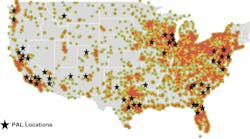Even great truck fleets with great safety records will be involved in an accident some day, if they drive enough miles The law of averages just catches up with you,” says Edward Nicklaus, managing partner of Nicklaus, Hyatt & Pena, P.A., Coral Gables, FL. “To make things tougher, the general public knows very little about trucks or trucking and years of bad press have made people — made juries — less than sympathetic to the trucking industry.”
It is a sobering thought, but Nicklaus is in a position to know about these things. He is a trial lawyer with 31 years of experience, much of it defending truck fleets. This summer, for instance, he notes, his firm successfully represented Penske Truck Leasing in a $7.5-million negligence lawsuit.
For fleet owners and managers, the message is clear: don't get mad, get ready. “If you do the right things and have the data to document it, then you will be better able to defend the cases you should defend,” Nicklaus advises. “Without the data, you may be right, but you are at risk because you can't successfully defend yourself.”
One category of data that can be worth its weight in damages and penalties is proof that drivers have been trained and have actually mastered critical skills. In the past, of course, this information was not easy to come by. All that most fleets could offer were the company's training materials, class attendance rosters and a safety manager ready to swear that the driver in question completed the course-evidence, but not actual proof.
Today fleets, as well as their insurance providers are looking for more. AON Truck Group, a division of AON Risk Services, for example, is recommending the computer-based TREAD-1 (Trucker Education And Development) driver training system to their fleet clients, according to Bill Prester, company president. “Training and retraining drivers is the most important thing a fleet can do to improve safety reduce their loss-related costs,” he says.
“What Prester and other insurers and fleets like about TREAD-1 is that it delivers quality driver training and proof of skill mastery,” explains E. Bruce Weiss, senior vice president of business development for Instructional Technologies Inc., Vancouver, WA (www.instructiontech.net). “The driving training modules we have developed are designed to actively involve and engage the student as he or she learns to make appropriate driving decisions. They also teach to mastery. Students cannot move ahead to complete a unit until they get everything right, and we record and document their results. This step is important because it provides fleets with the data they need to prove that a driver has actually mastered a particular skill. In the event of a lawsuit, this can be invaluable.”
The system is a suite of 31 driver-training lessons based on the industry skill and curriculum standards developed by the Professional Truck Driver Institute. It includes units on everything from air brakes to accident procedures, backing and docking to speed management, along with emergency procedures and three units on extreme conditions.
“If a driver skids on an icy street and hits someone, a fleet can say, ‘this driver took the Extreme Conditions training and successfully completed it. We prepared him as well as anyone could,’” notes Weiss.
“We prepared him as well as anyone could and we can prove it” is, in fact, becoming the new standard for driver training when it comes to litigation or even to getting insurance coverage. The good news is that there are now more ways to do just that, and in the process, to help improve highway safety for everyone.


